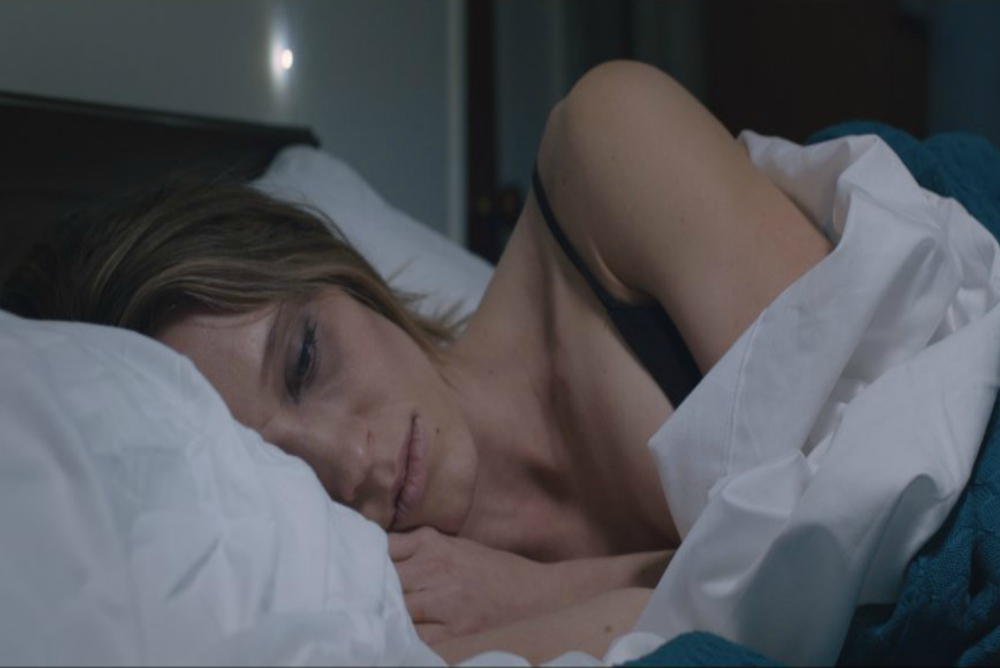A horror short featuring an all-female cast, The Price of Bones stars Summerisa Bell Stevens, Jordan Anton, and Lisa Dennett as two young women, Caprice (Stevens) and Heather (Anton), and Caprice’s unsympathetic mother (Dennett). The film is written by Samantha Kolesnik, directed by Brandon Taylor, and produced by Kolesnik, Melissa Sherry, Michael Sherry, and Hollow Tree Films.
The Price of Bones is about the intense pressure on girls and women to be thin, a pressure that, not least, creates severely disordered eating and exercise habits. Taking the perspective of Caprice, the film focuses both visually and narratively on bodies and food, showing us the constricted world of a woman who can’t see and experience anything that doesn’t have to do with the size of her body. She wakes up and looks at her body; she goes into the kitchen and is confronted with food she doesn’t want to eat and a mother who tries to make her eat it; she exercises with her friend, and they talk about eating and about how thin they are and how much thinner they need to be.
The first part of the film, in short, makes it dramatically clear how constricted—how drab, grey, and lifeless—is the world is of women who become obsessed with how much they put in their bodies. They are irreparably trapped by that obsession.
That the end of such an obsession is a kind of death (of interests, passions, relationships), and sometimes even literal death, is evident in a conversation Caprice and Heather have as they are running. They stop, and as Caprice bends over, Heather tells her: “I can see your bones,” referring to her spine, visible through her clothes even on a winter day. It’s clear that the women consider this a good thing because Heather then asks, “Can you see my bones?” and Caprice replies, “Everyone can see yours,” with a look on her face that chillingly conveys the competitiveness that the cult of thinness breeds among women, even friends. Indeed, Caprice and Heather can’t really be friends since they are also rivals. And what they are rivals in is the race to become nothing but bones—a state tantamount to death itself, all flesh, all life, gone. Caprice expresses this urge—this hatred of flesh that amounts to a death drive—when she later tells her mother she wants to “disappear.”
As the film turns from the more realistic horrors of women’s relationship to their bodies and into the terrain of the horror genre proper, it brilliantly renders in literal fashion the impetus to become ever more thinner, to become bones, to disappear. In doing so, The Price of Bones not only dramatizes what it’s like to be trapped in an eating disorder—hating yourself, hating anyone, even ostensible friends, who are a tiny bit thinner—but it shows, more broadly, how one of the characteristics of the horror genre is precisely the way it makes all real-life horrors, all amorphous terrors, into literal events, literal things.
The ending of The Price of Bones is expertly written and directed—a beautifully understated embodiment of the contradictory feelings of self-hatred, extreme competitiveness, and deformed desires that darkly lurk beneath the glossy cult of thinness.
Samantha Kolesnik’s screenplay for The Price of Bones was nominated for the “Best Short Screenplay” award at the 15th Annual Shriekfest Horror and Sci Fi Film Festival in Los Angeles, and The Price of Bones is currently playing at select festivals. To find out about general release dates, check in with the film’s official website and Facebook page.
NR | 11 min |Brandon Taylor | USA | 2016














